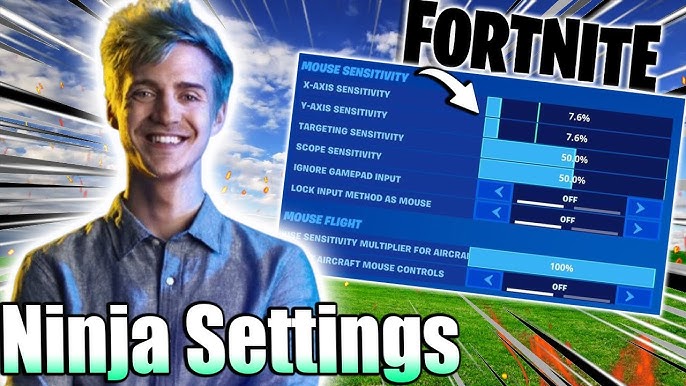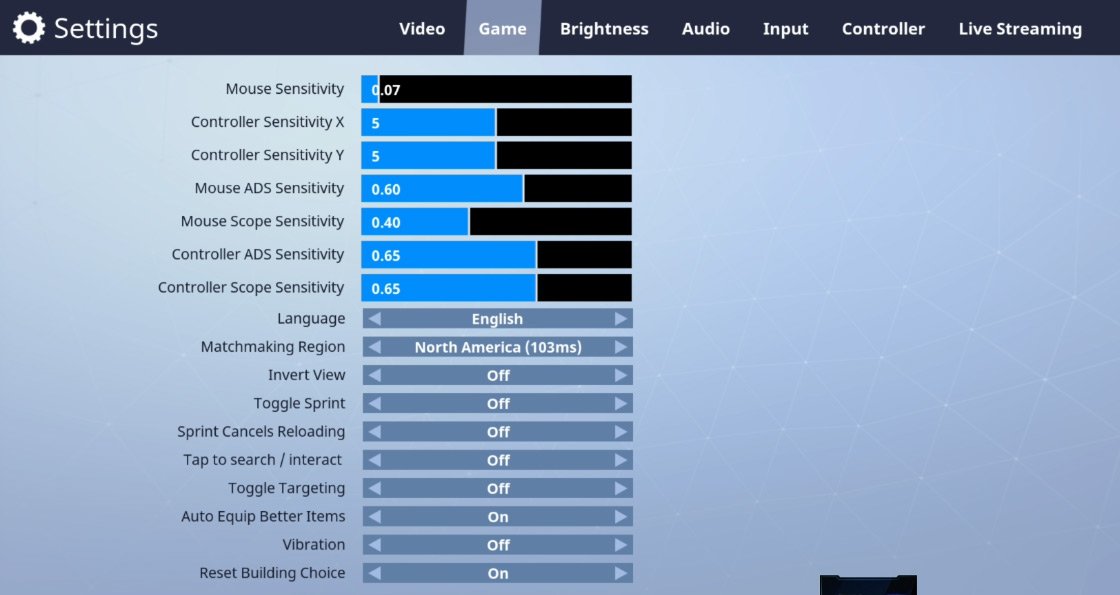
Ninja, one of the most iconic pro players in gaming, has a playstyle that many aim to replicate. His Fortnite settings go beyond simple configurations—they show how small adjustments can significantly improve performance in high-stakes gaming. By understanding Ninja's settings for mouse sensitivity, keybinds, video settings, and graphics preferences, beginners can potentially boost their gameplay and see better results in Fortnite.
This article will walk you through Ninja’s Fortnite settings across various dimensions, highlighting common issues players encounter when setting them up, and offering solutions for aspiring Fortnite players.
First thing First, Who is the Ninja Guy in Fortnite?
Ninja (Tyler Blevins) is a well-known pro gamer and streamer, most famous for his Fortnite skills. He skyrocketed to fame thanks to his high-level gameplay, fun personality, and engaging streams. Ninja quickly became a massive name in the gaming world, with millions of followers on Twitch and YouTube. His success in Fortnite helped him become one of the most recognizable faces in esports.
Why Was Ninja So Good at Fortnite?
Ninja became a top Fortnite player through his exceptional skill and relentless dedication. He plays around 50 games a day, analyzing each one, and his hypercompetitive nature ensures he averages about 15 wins daily, with a high of 29. His rise to fame in 2018, including winning the Fortnite Pro-Am at E3, cemented his status as one of the best players.

Mouse Settings
Mouse settings are fundamental for aiming accuracy and responsiveness in Fortnite, especially in a fast-paced environment where reflexes are crucial. Ninja's mouse settings include:
- Mouse Type: Logitech G Pro Wireless
- DPI (Dots Per Inch): 800
- Polling Rate: 1000 Hz
- X-Axis Sensitivity: 6.5%
- Y-Axis Sensitivity: 6.5%
- Targeting Sensitivity: 26.0%
- Scope Sensitivity: 28.0%
- Building Sensitivity: 100.0%
- Editing Sensitivity: 100.0%
The DPI setting specifies how sensitive the mouse is while moving across the screen, with a higher DPI resulting in faster cursor movement. For competitive players, a DPI of around 800 is often ideal due to its balance between speed and control. Ninja's equal sensitivity for both axes allows for consistent aiming and movement, making his gameplay smoother.
Keybinds
Keybinds in Fortnite are crucial for efficient gameplay as they dictate how players interact with the game environment. Ninja’s keybind configuration leverages both keyboard inputs and mouse buttons to optimize building and combat strategies. Below are Ninja's keybinds:
Movement Controls:
- Crouch: C
- Jump: Space Bar
- Sprint: L-Ctrl
Combat Controls:
- Harvesting Tool: 1
- Weapon Slot 1: 2
- Weapon Slot 2: 3
- Weapon Slot 3: 4
- Weapon Slot 4: Z
- Weapon Slot 5: X
- Use: E
Building Controls:
- Wall: Mouse Button 4
- Floor: Q
- Stairs: Mouse Button 5
- Roof: L-Shift
- Trap: 5
- Rotate Building: R
- Building Edit: F
- Turbo Building: On
Ninja’s use of mouse buttons for building actions exemplifies an efficient approach, allowing him to maximize performance without taking his fingers off the movement controls. The logical arrangement supports quick access to essential gameplay functions.

Video Settings
Ninja’s approach to video settings emphasizes performance and clarity. Below are his video settings in Fortnite:
- Window Mode: Fullscreen
- Resolution: 1920x1080
- Frame Rate Limit: 360 FPS
- V-Sync: Off
- HUD Scale: 85%
- Show FPS: On
The choice of a 1080p resolution strikes a balance between visual clarity and performance, ensuring that the game runs smoothly even on lower-end hardware. Setting the frame rate limit as high as possible can help Ninja maintain consistent performance during intense firefights.
Audio Settings
- Sound Quality: High (to clearly hear footsteps and gunshots)
- Background Audio: Off or very low
- Sound Effects Volume: High (for better awareness of the environment)
- Voice Chat Volume: Personal preference
Graphic Settings
The visual components of Fortnite directly affect gameplay experience. Many players forget the importance of graphic settings, which can impact visibility and performance during matches:
- Brightness: 121%
- Color Blind Mode: Off
- Anti-Aliasing: Off
- Shadows: Off
- Textures: Medium
- Effects: Low
- Post Processing: Low
- View Distance: Epic
Ninja’s graphic settings prioritize visibility, minimizing distractions that could obscure enemy detection. Lowering shadows and effects allows for enhanced opponent visibility and better frames per second, which is vital for swift response times.
Sensitivity
Mouse sensitivity is often a debated topic among gamers. However, Ninja's sensitivity provides a comprehensive reference point for players seeking to enhance their own precision:
- Mouse Sensitivity X: 17%
- Mouse Sensitivity Y: 17%
- Targeting Sensitivity: 35%
- Scoped Sensitivity: 40%
A balanced sensitivity ensures that players can maintain control while executing rapid, precise movements. Ninja’s approach to sensitivity leverages both speed and accuracy, allowing for effective aim during combat. Players can adjust their own sensitivity to a similar structure to test what feels best during their gameplay sessions.
The Importance of Sensitivity
Sensitivity settings are crucial for several reasons:
- Flick Shots: A player may need to quickly reposition their aim when engaging enemies. A higher sensitivity can make this easier, but it can come at the cost of accuracy if set too high.
- Building Speed: Pros often build structures rapidly to gain an advantage. A comfortable sensitivity setting allows for fluid mouse movement, crucial during fast-paced gameplay.
Crosshair Settings
A well-designed crosshair may enhance aiming precision, providing players the best chance to secure eliminations. While detailed crosshair settings for Ninja are less discussed, most pros recommend clear, non-disruptive crosshair colors on a contrasting background to enhance visibility. Sensitivity settings are crucial for several reasons:
- Flick Shots: A player may need to quickly reposition their aim when engaging enemies. A higher sensitivity can make this easier, but it can come at the cost of accuracy if set too high.
- Building Speed: Pros often build structures rapidly to gain an advantage. A comfortable sensitivity setting allows for fluid mouse movement, crucial during fast-paced gameplay.
Suggested Custom Crosshair:
- Color: Cyan (#00ffff)
- Outlines: Off
- Inner Lines: On
- Outer Lines: Off
Opting for high-contrast colors (like Ninja’s choice) makes your crosshair noticeable against a busy background.
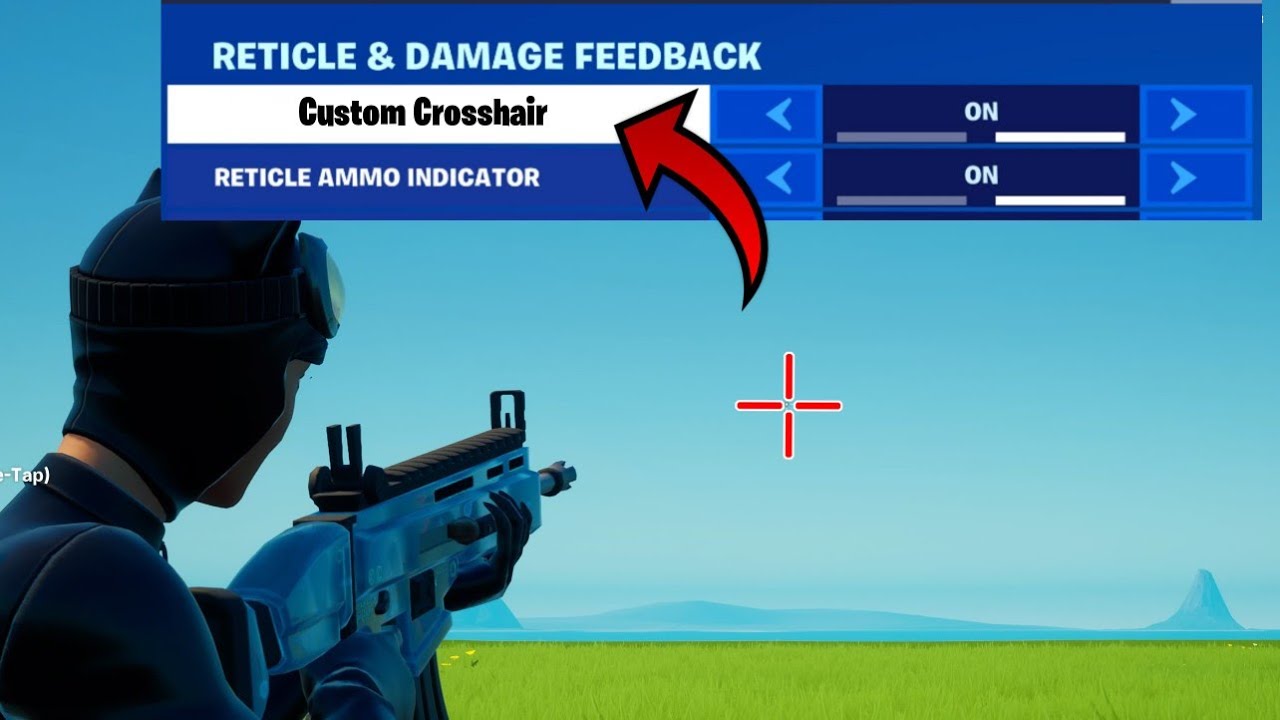
Peripheral Setup
It's worth noting that Ninja's peripherals complement his settings, offering advantages during competition:
- Headset: Beyerdynamic DT 1990 Pro
- Keyboard: SteelSeries Apex Pro TKL
- Monitor: Alienware AW2518H (240Hz refresh rate)
Each peripheral works in tandem with his settings to create an experience designed for rapid response and minimal latency, which is key to climbing the competitive ladder in Fortnite.
How much is Ninja's gaming setup?
Ninja's gaming setup, featuring high-end components and professional peripherals, can cost between $3,000 and $6,000. This includes a powerful PC, multiple monitors, premium audio and video gear for streaming, and specialized gaming peripherals like keyboards and mice. The actual cost might vary based on specific brands and models used.
Common Issues and Solutions When Players Encounter Ninja’s Fortnite Settings
Players who try to replicate Ninja's Fortnite settings may face several challenges. Here are the common issues and practical solutions to help you get the most out of your keybinds and mouse settings:
Confusion Between Mouse and Keyboard Bindings:
- Issue: Players using the Logitech G600 mouse or similar mice may face confusion when trying to assign specific functions (like building a wall) to mouse buttons. For example, when trying to bind Mouse Button 4 for building walls, Fortnite may prompt that it will overwrite the binding for Weapon Slot 3 on the keyboard.
- Cause: The mouse and keyboard may be mapped to the same key (e.g., both the 4 key on the keyboard and Mouse Button 4 may be set to the same function), causing conflicts.
- Solution: To fix this, players need to dissociate the keyboard and mouse bindings in their mouse software (e.g., Logitech G Hub). This can be done by remapping the mouse buttons to different keys that don't conflict with keyboard keys.
2. Laptop Key Restrictions (F1-F5 Keys):
- Issue: Players using laptops (especially those with Fn-mapped function keys, like F1-F5 being tied to volume control) may struggle to use certain keybinds for Fortnite. These keys can interfere with essential functions during gameplay.
- Cause: Many laptops have multimedia keys (volume control, brightness, etc.) mapped to F1-F5. Pressing F1-F5 requires the Fn button to be held down, which is cumbersome during fast-paced gameplay.
- Solution: Players may want to remap their F1-F5 keys in Fortnite to other keys or avoid using these keys entirely. It's also worth considering an external keyboard with dedicated F1-F12 keys for a smoother experience.
3. Default Keybind Conflicts:
- Issue: Some players, especially newcomers, may struggle with the default keybinds in Fortnite. Trying to replicate Ninja's settings without fully understanding the reasoning behind them can lead to discomfort or inefficiency in their gameplay.
- Cause: Keybindings that work well for a pro player like Ninja may not necessarily suit every player, especially those new to the game or without experience customizing key setups.
- Solution: New players should start with default keybinds to get a feel for the game and then gradually experiment with Ninja's settings or other optimized setups that work best for their comfort and playstyle.
4. Thumb Button Overload on Mouse:
- Issue: Ninja uses mouse buttons for building (such as the wall bind on Mouse Button 4), which may require players to use their thumb too much for key actions. This can lead to strain or confusion, especially for players not used to multiple side mouse buttons.
- Cause: Mice like the Logitech G600 have numerous side buttons, but relying too heavily on the thumb for actions like building and editing can be inefficient and uncomfortable.
- Solution: Players should consider spreading their binds across different fingers, not just relying on the thumb. Using other buttons on the mouse (like MB5, MB6) or keyboard keys for important functions can help reduce strain and improve efficiency.
5. Muscle Memory and Keybind Changes:
- Issue: Players who are used to certain keybinds may find it difficult to adjust to Ninja’s layout, especially if they’ve spent a lot of time with custom key setups or default keybinds.
- Cause: Changing keybinds too abruptly can interfere with muscle memory, making gameplay feel awkward and slowing down reaction times.
- Solution: For players already comfortable with certain keybinds, it’s important to gradually ease into Ninja’s settings or experiment with smaller changes, giving time for muscle memory to adapt.
6. Overloading the Keybinds for Efficiency:
- Issue: New players may try to adopt too many advanced binds (like Ninja’s extensive use of side buttons for building) without fully understanding the need for efficiency in gameplay. This can lead to an overcomplicated setup that is difficult to manage during intense moments.
- Cause: Advanced players often use complex keybinds to optimize their gameplay, but these setups can be overwhelming for beginners or those not used to fast-paced keypresses.
- Solution: Beginners should start simple, using fewer side buttons and building gradually from there. Focus on binding essential actions to fingers that naturally fall on the keys and gradually introduce more advanced binds as they gain confidence.
Best Way to Increase High FPS and Reduce Lag in Fortnite
Maximize your Fortnite gaming experience with LagoFast, the ultimate FPS solution. Engineered with state-of-the-art technology, LagoFast ensures seamless gameplay by delivering lightning-fast frame rates, keeping you steps ahead of the competition at every turn. Its intuitive design optimizes your system for peak performance, eliminating ghosting and tearing for an immersive gaming session.
Bid farewell to lag and welcome uninterrupted action with LagoFast’s real-time optimization, promising enhanced connection stability and reduced delays even in the most intense multiplayer battles. Unleash the true potential of your hardware and embark on a journey through Fortnite’s landscapes without constraints. Don’t settle for low FPS, join the ranks of elite gamers with LagoFast today.
Tutorial to use LagoFast for maximum FPS in Fortnite:
Step 1: Click the Free Trial button.
Step 2: Select the “Game Boost button”, and search for Fortnite in LagoFast before you launch it.
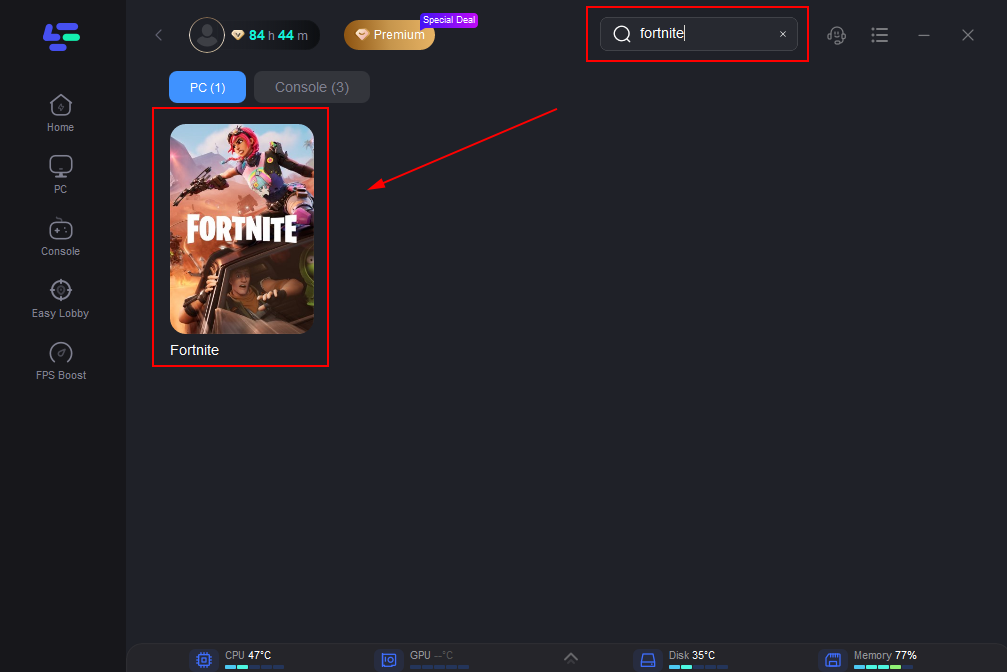
Step 3: Click on “Select Server” to switch to a server that maximizes FPS, then click on the “Node” on the right to get a stable Node.
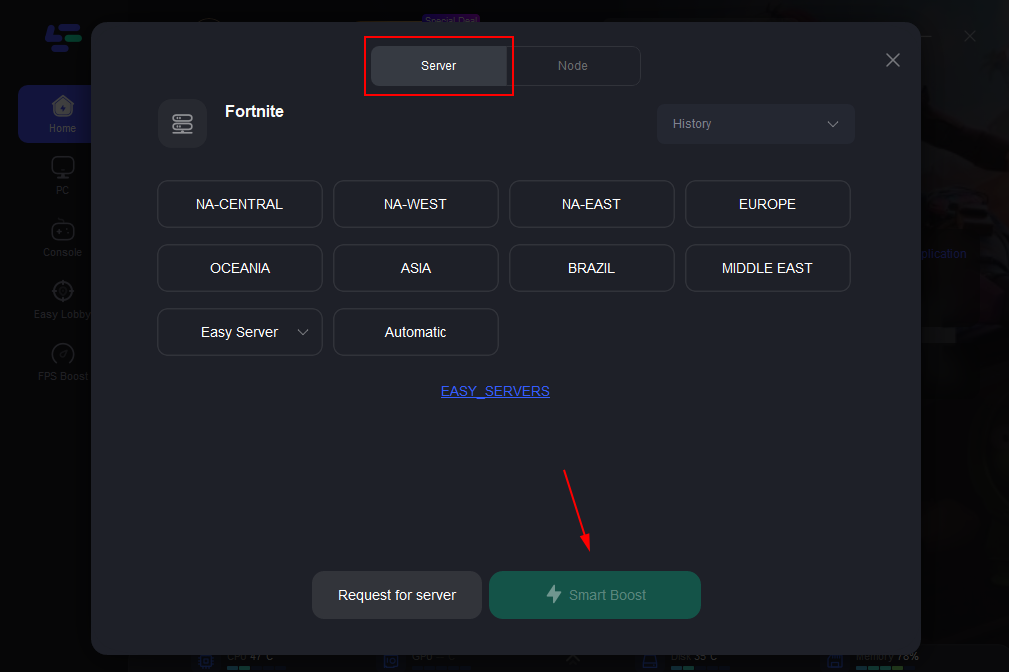
Step 4: Clicking the “Smart Boost button”, the specific game ping, packet loss, and network type will be presented on the right side. Finally, click the “Start Game button” to start the game.
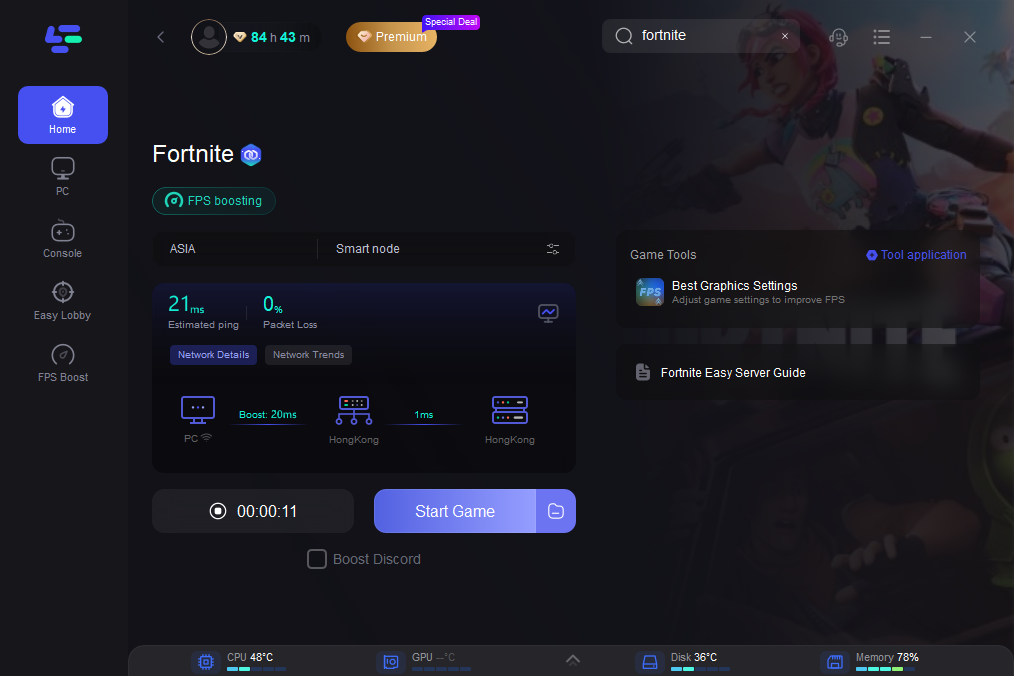
Conclusion
Ninja’s Fortnite settings are carefully adjusted to maximize performance, especially during complex moves and fast-paced gameplay. While it’s helpful to start with his settings, remember that the real magic happens when you tailor them to your own style. Use Ninja’s choices as a starting point, then experiment and adjust based on what feels right for you. This way, you’ll refine your approach and find your own path to success in Fortnite’s competitive world.

Boost Your Game with LagoFast for Epic Speed
Play harder, faster. LagoFast game booster eliminates stutter and lags on PC, mobile, or Mac—win every match!
Quickly Reduce Game Lag and Ping!
Boost FPS for Smoother Gameplay!
